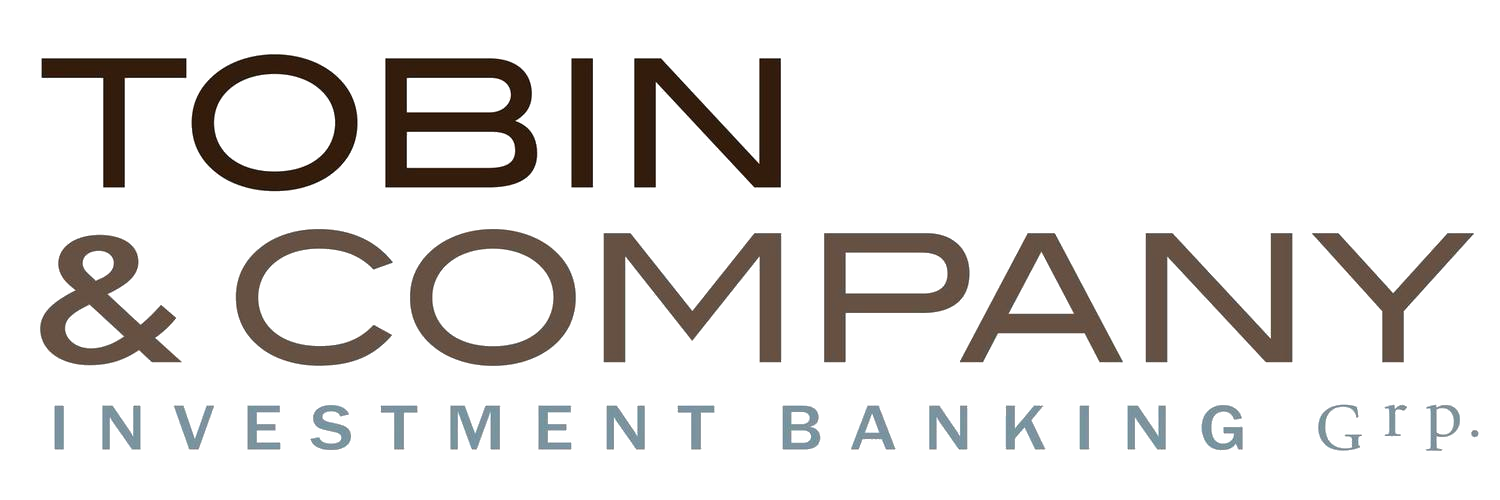Introduction: The Art and Discipline of Valuation
Valuing a company is both a technical exercise and a profound act of discernment. I like to say that the practice is both an art and a science. It requires analytical skills, market fluency, and a disciplined understanding of what drives worth in a dynamic environment. At TOBIN, valuation is not an abstraction. It is the disciplined synthesis of financial analysis, market intelligence, and professional judgment – brought together to establish a fair and defensible conclusion of value for your company.
For over two decades, TOBIN has guided clients through transactions where valuation is pivotal: M&A, capital raises, shareholder disputes, option pricing, and fairness opinions. Each assignment demands a clear objective – to arrive at an estimate of Fair Market Value – and an unwavering adherence to independence and analytical rigor.
Understanding Fair Market Value
The foundation of every valuation is the concept of Fair Market Value, defined as the price at which property would change hands between a willing buyer and a willing seller, neither under compulsion, both possessing reasonable knowledge of relevant facts.
This definition of Fair Market Value presumes symmetry: equivalent negotiating skill, balanced information, and rational intent. In practice, however, market participants often differ in strategy, risk tolerance, and perception of opportunity. TOBIN’s role is to navigate those asymmetries and distill a grounded, objective valuation, one that reflects both current market realities and forward-looking prospects.
Fair Market Value serves multiple purposes. It underpins fairness opinions, informs 409A valuations for stock options, and provides protection against compliance risks under federal statutes such as the Anti-Kickback Statute. In each context, the objective remains constant: to provide a professional, independent estimate of worth that withstands regulatory, fiduciary, and market scrutiny.
The TOBIN Valuation Assessment Process
TOBIN’s valuation process integrates quantitative rigor and qualitative insight. TOBIN typically employs three core methodologies, harmonizing them to produce a final conclusion of value:
1. Guideline Public Company Comparison – Analyzes the valuation metrics of comparable publicly traded companies offering similar products or services or with similar constructs in revenue generation and customer base.
2. Guideline Transaction Comparison – Examines prices paid in actual arm’s-length mergers and acquisitions of comparable companies.
3. Discounted Cash Flow (DCF) Analysis – Projects a company’s future earnings and discounts them back to present value using a carefully derived cost of capital.
Each method contributes a distinct lens. Public comparables reveal how the market prices industry peers. Transaction comparables capture precedent market behavior. DCF analysis isolates intrinsic value based on expected performance and capital costs. TOBIN weighs these perspectives in concert to reach a unified and defensible conclusion.
Guideline Public Company Comparison
This approach grounds valuation in the observable market. TOBIN identifies a set of publicly traded companies that mirror the subject firm’s operations, customer base, and growth profile. We deploy a variety of resources to select these “public comparables’, including data sets that we subscribe to and publicly available data on the Internet. While such public comparables may sometimes differ in scale to our subject company, the capital markets tend to translate relative valuation multiples consistently across size categories, making this comparison instructive.
Through careful normalization of metrics, which TOBIN does through a very detailed credit analysis of each comparable company and our client, we weight our seven or eight comparable companies – which we spent a lot of time selecting, to best represent their qualities relative to the subject company. Once weighted, TOBIN extrapolates the comparable revenue and EBITDA multiples of the comparables onto the revenue and EBITDA of our client to derive a valuation range which translates that public company knowledge onto our subject company. We then derive an indicated value that reflect how investors value comparable enterprises. TOBIN supplements this quantitative work with qualitative evaluation and an adjustment to the results for size, which reflects differences from the public companies in management depth, market share, customer concentration, and competitive differentiation.
Guideline Transaction Comparison
Real-world deal data reveal what strategic and financial buyers have paid for similar businesses. TOBIN examines arm’s-length transactions, available to us through another database that we subscribe to, eliminating outliers and normalizing results to reflect fair conditions. We generally eliminate outliers by relying on mean and median results in the multiples analysis, and we also weight each contributing transaction comp based on what it individually contributes to the results, if necessary.
TOBIN’s analysis sometimes provides perspective on acquisition premiums, synergies, and transaction structures, if appropriate. Because M&A markets fluctuate with credit cycles and investor sentiment, TOBIN contextualizes every comparable against the prevailing conditions at the time of that transaction. Our process yields a range of implied values rooted in actual market behavior—what buyers have paid, not merely what they might pay.
Discounted Cash Flow Analysis
The DCF method focuses on a company’s ability to generate future economic benefit. Using management’s projections, we model anticipated cash flows and discount them to present value using a Weighted Average Cost of Capital (WACC) derived from the firm’s specific debt and equity profile. We also investigate management’s projections for reasonableness, market conditions, economic environment and past financial performance.
The DCF is the purest test of intrinsic value—it measures worth independent of market noise. But it can be easily manipulated, so TOBIN approaches it with caution. It demands disciplined assumptions: realistic growth, normalized margins, and credible capital structure inputs, especially for future working capital needs. TOBIN applies skepticism and experience, ensuring that each assumption is supportable and transparent.
Special Adjustments: Discounts and Premiums
Valuation is rarely linear. Certain ownership, size or liquidity characteristics require adjustments to reflect true economic reality. TOBIN applies these with precision:
- Discount for Lack of Marketability (DLOM): Reflects the reduced liquidity of privately held shares.
- Discount for Lack of Control (DLOC): Adjusts for minority positions lacking governance influence.
- Discount for Lack of Size: Reflects that many of our clients are much smaller than the public comparables that we can source.
- Minority Interest Discount: Applies to ownership stakes below majority control.
- Equity Risk Premium: Captures the expected excess return of equities relative to risk-free investments.
Each adjustment requires reasoned judgment and evidence. And they must all coalesce together. These discounts and premiums ensure that the valuation captures not just theoretical value but also the practical realities of ownership, control, liquidity and market conditions.
Conclusion of Value: Synthesis and Insight
At the conclusion of our process, TOBIN harmonizes the results of each method, assigning weightings appropriate to the client’s industry, financial condition, and transaction context. This is my favorite part of the valuation process.
We review the scientific results and note how the three legs of the valuations speak to one another. Are they aligned? Is there an outlier? How is that explained? How is it reeled in? This is where decades of investment banking and technical experience pay off – in delivering wisdom to the result for our client.
The output is not a single static figure but a reasoned conclusion—a range of value informed by empirical evidence and professional interpretation. We deliver this through a comprehensive narrative report that details every input, calculation, and consideration. The report’s structure offers clarity to boards, management, and investors alike.
Our valuations do not stop at conclusion—they include insight. We identify value drivers that can elevate a company’s worth over time: operational leverage, recurring revenue, brand differentiation, or balance sheet optimization. Valuation, in TOBIN’s hands, becomes both a measure and a roadmap.
When a Valuation Becomes Essential
Valuations serve many purposes. They guide equity compensation under Section 409A, inform fairness opinions in mergers, support compliance under federal law, and provide defensible foundations for shareholder negotiations.
Valuations also provide company owners with a strong basis for understanding what their company is worth, especially as they consider going to market and selling their prized possession. They serve as strategic instruments—tools for exit planning, capital structuring, and corporate governance.
TOBIN’s independence ensures objectivity; our process ensures credibility; our experience ensures that every valuation can withstand the most demanding scrutiny.
The TOBIN Difference
TOBIN is one of the only solely. 100% female-owned investment banks and broker-dealers in the United States, bringing Wall Street execution standards to the middle market. Every engagement is led by the senior professional who has served clients at firms such as Goldman Sachs, Salomon Brothers, and Bank of America.
We do not outsource judgment. Our valuations are executed with discretion, precision, and an unwavering commitment to integrity. In a marketplace awash with formulas, TOBIN’s process stands apart—anchored by human discernment, informed by decades of transaction experience, and designed to empower clients with clarity and confidence.
If your company is considering a transaction, succession plan, or ownership reorganization, now is the time to understand its true worth. TOBIN’s Valuation Services deliver clear, defensible assessments that align with your strategic objectives and regulatory requirements.

Justine Tobin
Founder and CEO
(704) 334-2772
This newsletter is not intended to provide legal or investment advice and no legal or business decision should be based on its content. FYI.



















